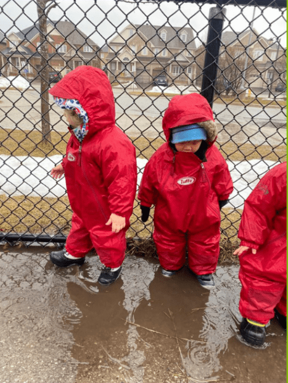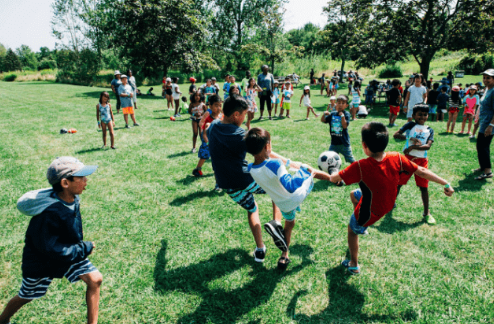Our child care programs, summer camp, and forest school are child-centered and inquiry based.
Upper Canada Child Care (UCCC) programs see the benefits of outdoor play and building connections with nature every day. We believe in “venturing outside the fence” so much that seasonal visits to our Forest School – Upper Canada Child Care are an important part of our preschool programs.
Maybe our outdoor focus is what drew you to Upper Canada Child Care; if you’re already encouraging outdoor play at home, that’s great, keep it up! But if you’re still on (or inside) the fence, or just need a bit of encouragement to get started, here’s a list of ten benefits of outdoor play:
1. It’s healthy.
According to Outdoor Play Canada | Research, there are significant benefits of playing outdoors in all types of weather. While some families may still believe children should stay inside so as not to “catch a cold” playing outdoors, illness is more likely to spread indoors, and one of the main benefits of outdoor play is that it helps to boost immune systems.
Of course, as a licensed childcare operator, UCCC is guided by foundational documents such as How Does Learning Happen? Ontario’s Pedagogy for the Early Years which are grounded in research. We know children flourish when programs support active physical play in natural outdoor spaces and back before children (and adults) all had so much screen time, this is what we used to do.
Our Camp and Outdoor Education Coordinator, Nicole (RECE, and Forest School Practitioner), is UCCC’S resident expert on all things outdoor play. Nicole currently provides leadership and resources for all our programs and summer camps in addition to running our Forest School program, but she also worked as a centre supervisor. Nicole is very familiar with implementing outdoor programs in a childcare environment. She shared with us that when her centre moved to an outdoor focus, there was less illness. Outside air + exercise + vitamin D = winning combination!

To support children’s enjoyment of outdoor play we ensure they dress appropriately for the weather. As Alfred Wainwright said: “there is no such thing as bad weather; only inappropriate clothing,” We ask families to send extra clothing to support outdoor play on rainy/snowy days, and our full-day centres provide “muddy buddies” (rubber suits that keep children dry and clothes clean).
2) It’s fun.
Children are experts in how to have fun through play and it’s how they learn. Adapting a traditionally indoor children program and taking it outside of the classroom makes things fun in a different way. We can also bring the outdoors into the classroom, collecting natural items such as pinecones and rocks for art or “loose parts play”. Water and sand are very popular sensory play stations. Bonus: clean up afterward is much easier when outside.
Fun is Learning. Learning is fun.
One of the benefits of outdoor play that you may not be aware of is its positive impact on academics. Nicole found that children who hadn’t spent much time in forested areas became more creative and imaginative the more time they spent in nature. Additionally, she noticed that reading and writing activities linked to children’s forest experiences helped increase children’s literacy skills.
What about the weather?
One of the top concerns we hear from parents is about weather conditions; that’s understandable given the hot and cold extremes Ontario enjoys seasonally. Our programs can and do adapt so children can experience a variety of weather conditions, finding ways to keep comfortable, such as:
- ensuring that children dress appropriately for the weather;
- using shelters, tents, umbrellas, mist bottles, and water play;
- reminding children to take breaks and to stay hydrated by drinking water;
- having varied activity options, from high energy to calmer ones;
- doing “body check ins” to see how children are feeling, and teaching them how to respond; and
- limiting outdoor time in extreme conditions.
We take all safety precautions and we make the outdoor experience fun! You can use all these methods at home to support outdoor play.
What if my child wants to stay inside?
If you find your child saying they don’t want to go outside, maybe what they don’t want is the transition from one activity to another (this can be difficult for adults too!). Like with learning to try a variety of foods, it’s important not to give up on something new. They might also need the support of your enthusiasm to find some of their own. You may need to co-play a few times to help them to discover the interesting and fun things to do outside. Starting off with a planned activity like a scavenger hunt or creating outdoor art, even a picnic is a fun way to bridge that gap together. And once it becomes more of a habit to get outside, you may find kids want to stay outside because they’re having so much fun!

3) It builds confidence.
Outdoor play benefits children by encouraging them to explore different environments and activities with confidence. At UCCC, because we view children as capable, we promote healthy and safe risk taking through activities such as slacklining and balancing on logs etc. In addition to building confidence, slacklining develops balance, improves core strength, provides a total body workout, improves stability muscles, improves focus, and develops coordination. When children engage in risky play, they’re experimenting with body awareness and learning to assess their own level of risk.
Practicing and improving all these skills can help with injury prevention. While operating our White Pines Forest School program, Nicole observed that increasing “risky” activities increased gross motor skills, which also reduced tripping/falling accidents.
So, the next time your child wants to get up on a log, if your first reaction is to stop them, remember that this activity not only develops balance, but also physical strength, focus, concentration, self-confidence and self-esteem, spatial reasoning skills, flexibility (in body and mind), and critical thinking.
We want children to feel confident about the choices they make. There’s a link between trusting children to make good decisions for themselves and the amount of confidence they feel.
4) It’s not expensive.
This one is short and sweet.
Something free? In these times? Yes please. There’s no entry fee for stepping outside. The only rate that will increase is your heartrate.
5) It promotes environmentally sustainable behaviours and stewardship.
It’s environmentally friendly to spend more time playing in nature. So, rather than buying more toys which can create clutter and be costly (see point 4), consider letting ‘nature’s playground’ provide.
As mentioned in a recent article from Playing Outside: Why It’s Important for Kids – HealthyChildren.org, there’s a connection between children spending time in nature and environmental stewardship. Nicole described to us how children developed connection to place over time by visiting the forest several times per week. They learned to track seasonal changes and recognize animal tracks. Furthermore, they wanted to care for and clean up the forest. The children were well on the pathway of stewardship, which started with building connection to place.
Our White Pines Forest School (WPFS) has a large focus on environmental stewardship. It’s an added perk of our preschool programs that children can visit WPFS seasonally for no extra charge.
See more about stewardship here: Child and Nature Alliance of Canada (childnature.ca)
6) It’s uncomplicated.
To facilitate outdoor play, although you may CHOOSE to, you don’t NEED to bring anything with you; children can just use whatever is close by. Added bonus: nature’s stock of supplies changes seasonally!
One important benefit of outdoor play is the increased opportunity to be creative and engage in imaginative play. Puddles are opportunities to splash, ice is a chance to practice balancing. Sticks can become wands or fishing rods, rocks can become crystals, used for skipping across water, or painted. I’ve often found “treasures” (rocks and feathers) stuffed into coat pockets and backpacks. Children may create a whole story as they play; they have endless ideas. And they will be happy to guide us if we play along.
7) It promotes resilience.
Our attitudes influence our children and can contribute to their resilience. One example is in the way we view the weather. I no longer see rainy days as “bad weather”. Nicole teaches that there is value in engaging with all types of weather in all seasons, including when It’s dark, rainy, cold. We don’t just engage when things are “easy”; instead, we face challenges. I too want my child to know that “life is not all sunshine and roses.” Allowing kids to participate in “risky play” is part of building resilience.
Fortunately, working in childcare and being a parent has reminded me about the importance of fun and value of all kinds of play, including play that is messy and “risky.” (I remind myself of this when I’m cleaning dirt off clothes or when my instinct is to shout, “be careful!”).
Fortunately, working with children and being a parent has forced me to become more resilient as well.
8) It helps with self-regulation.
Have you noticed a calmness that comes from being outdoors? Spending more time outside helps everyone reduce stress, better deal with mental fatigue, while increasing patience and capacity for attention. Similarly, in our centres, ‘behaviours’ often lessen or disappear when children are outside with space to move and express their energy. This is one of the more unexpected benefits of outdoor play: how it positively affects children’s ability to cope.
9) It fosters communication, social skills, problem solving skills, creativity, and a sense of community
Fort challenge, anyone?! At UCCC we love building forts. Knowing how to build a shelter isn’t just useful in a practical sense; it requires communication, cooperation, and negotiation skills. Everything can become a learning opportunity. For example, if your child wants to make a fort with sticks, this fun activity is also a STEM (Science, Technology, Engineering, Math) activity. You can support them by praising their effort and asking questions such as: What is the best/place location to build a stick fort? What shape should it be? What materials can we use and where will we find them?
Outdoor activity could be as simple as going for a nature walk or to the park. Further, these activities come with a social benefit, such as kids making connections with others at the park. Meeting people in your neighbourhood builds connection, builds community, which builds safety.
10) It’s a chance to make memories.
Lastly, and importantly, when you get outside as a family you get to spend quality time together. So, we hope you’re inspired to enjoy the benefits of outdoor play firsthand more often!
For more information about our programs check out UCCC’s Program Statement and our Resources Page.
By Christine Tyrrell, Communications and Marketing Coordinator